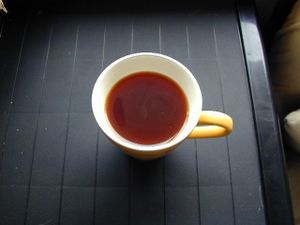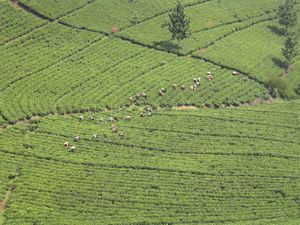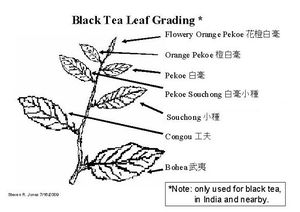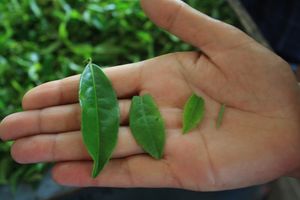شاي أسود
الشاي الأسود Black tea، هو أحد أنواع الشاي الأكثر أكسدة من شاي الأولونگ، الشاي الأخضر والأبيض. يتميز الشاي الأسود بقوة طعمه عن بقية أنواع الشاي المؤكسدة الأخرى.
الأنواع الأربعة جميعها مصنوعة من أوراق شجيرات الشاي.
في اللغة الصينية ولغات البلدان المجاورة، يسمى الشاي الأسود "بالشاي الأحمر" (بالصينية 紅茶 hóngchá، تُنطق [xʊ̌ŋtʂʰɑ̌]; باليابانية 紅茶 kōcha؛ بالكورية 홍차 hongcha، بالبنغالية লাল চা Lal cha، بالأسامية ৰঙা চাহ Ronga chah)، كوصف للون السائل؛ أما مصطلح الشاي الأسود فيشير إلى الأوراق المؤكسدة المصنوع منها الشاي.
الأنواع
بصفة عامة، يسمى الشاي الأسود الغير مخلوط باسم المنطقة التي أُنتج فيها.[1] عادة،هناك عدة مناطق تشتهر بإنتاج الشاي باختلاف المذاق.
| البلد | الشاي | الاسم الأصلي | الأصل | الوصف | |
|---|---|---|---|---|---|
| الصين | كونگوو | Congou | gōngfū-hóngchá (工夫红茶) | فوجيان | |
| پانيانگ كونگوو | Tǎnyáng-gōngfū (坦洋工夫) | قرية تانيانگ، Fu'an، فوجيان | The king of the Fujian Artisan Red Teas. One of the three Famous Fujian Reds. | ||
| Zhenghe Congou | Zhènghé-gōngfu (政和工夫) | Zhenghe County, Fujian Province | One of the three Famous Fujian Reds, with a slight honey flavor. | ||
| Bailin congou | Báilín-gōngfu (白琳工夫) | Bailin Town, Fuding, Fujian Province | One of the three Famous Fujian Reds. | ||
| Lapsang souchong | Lapsang souchong | Zhèngshān-xiăozhŏng (正山小种) | Wuyi Mountains, Fujian Province | Dried over burning pine, thereby developing a strong smoky flavour. | |
| Yin Jun Mei (Silver Steed Eyebrow) | yínjùnméi (银骏眉) | A higher grade version of Zhengshan xiaozhong (aka. Lapsang Souchong) | |||
| Jin Jun Mei (Golden Steed Eybrow) | jīnjùnméi (金骏眉) | One of the highest grade red teas in mainland China. | |||
| Keemun | Qímén-hóngchá (祁门红茶) | Qimen County, Anhui Province | One of China's Famous Teas. The aroma of tea is fruity, with hints of pine, dried plum and floweriness. | ||
| Dianhong (Yunnan) | Yúnnán-hóngchá (云南红茶) / diānhóng (滇红) | Yunnan Province | Well known for dark malty teas and golden bud teas. | ||
| Yingdehong | Yīngdé-hóngchá (英德红茶) | Yingde, Guangdong Province | The tea has a cocoa-like aroma and a sweet aftertaste, one can find a peppery note. | ||
| Jiu Qu Hong Mei (Nine Winding Red Plum) | jiǔ-qǔ-hóng-méi (九曲红梅) | Hangzhou, Zhejiang Province | This tea is characterised by tight fishhook-like leaves with a lustrous black color. The infusion is brightly reddish and has a long smooth aftertaste. | ||
| الهند | أسام | Ôxôm cah (অসম চাহ) | ولاية أسام | Full bodied, strong and distinctively malty tea from the lowlands of Assam. It is the highest produced tea in the world.[بحاجة لمصدر][2] | |
| دارجيلينگ | Dārjiliṁ cā (দার্জিলিং চা) | ولاية غرب البنغال | Thin bodied, floral and fruity tea from Darjeeling with defining muscatel tones. Today often processed as a mixture of black, green and oolong elements, though still classed as black. | ||
| كانگرا | Kāngada cāy (कांगड़ा चाय) | منطقة كانگرا، ولاية هيماچال پرادش | It produces basil-cinnamon, java plum-blueberry blends and Chinese hybrids that is varied with others as a pale liquor, it has a subtle pungency with a vegetal aroma.[3][4] | ||
| مونار | Mūnnār cāya (മൂന്നാർ ചായ) | بلدة مونار، مقاطعة إدوكي، ولاية كرلا | This variety produces a strong bodied golden yellow liquor with refreshing briskness and a hint of fruit. It has a medium toned fragrance, that is akin to malted biscuits.[5] | ||
| نيلگيري | Nīlakiri tēnīr (நீலகிரி தேநீர்) | مقاطعة نيلگيريس، ولاية تاميل نادو | Intensely aromatic, strong, and fragrant tea from the Nilgiri Hills of Karnataka, Kerala and Tamil Nadu. | ||
| كوريا | Jaekseol (Bird's tongue) | jaekseol-cha (잭설차) | Hadong County, South Gyeongsang Province | Jaekseol tea is golden, light scarlet in color and has a sweet, clean taste.[6] | |
| نيپال | نيپال | Nēpālī ciyā (नेपाली चिया) | Similar to Darjeeling tea in its appearance, aroma and fruity taste, with subtle variation. | ||
| سيرلانكا | سيلاني | Silōn tē (සිලෝන් තේ) | It is grown on numerous estates which vary in altitude and taste. High-grown tea is honey golden liquor and light and is considered to be among the best teas in terms of its distinct flavor, aroma, and strength. Low-grown teas are a burgundy brown liquor and stronger. Mid-grown teas are strong, rich and full-bodied. | ||
| تايوان | صن مون ليك | Rìyuè-tán-hóngchá (日月潭紅茶) | Sun Moon Lake, Nantou City, Nantou County | Honey rich tones, sweet osmanthus, cinnamon and peppermint. | |
| تركيا | Rize | Rize çayı | Rize, Rize Province, Black Sea Region | Characterised by its strong taste, when brewed it is mahogany in color. Traditionally served with beet sugar crystals. | |
الخلطات
عادة ما يتم خلط وإضافة خلطات نباتات أخرى مختلفة إلى الشاي الأخضر للحصول على المشروب.
| الخليط | الوصف |
|---|---|
| شاي إيرل گراي | شاي مع زيت البرگاموت.[7] |
| شاي الإفطار الإنگليزي | Full-bodied, robust, rich and blended to go well with milk and sugar. |
| شاي بعد الظهر الإنگليزي | Medium bodied, bright and refreshing. Strong Assam and Kenyan teas are blended with Ceylon which adds a light, brisk quality to the blend. |
| شاي الإفطار الاسكتلندي | Blend of several black teas: most often Assam teas and, less often, other types of black tea. |
| شاي مسالا | Combines black tea, spices, milk, and a sweetener such as sugar or honey; a beverage from India (introduced by the British East India company to encourage tea consumption among Indians and to compete with Chinese tea plantations). Masala chai has been adapted in the West with changes to the method of preparation.[8] |
التصنيع
تصنيف الشاي
التخمير
عادة ما يتم إضافة 4 جرامات من الشاي لكل 200 مل من الماء.[9] على عكس الشاي الأخضر والذي يكون أفضل عندما يتم تخميره على درجات الحرارة المرتفعة، فإن الشاي الأسود يجب أن يضاف إلى ماء مغلي بدرجة حرارة 90-95 °س. يخمر أولاً 60 ثانية، ثم 40 ث، ثم مرة ثالثة 60 ثانية. إذا كان الشاي بنوعية جيدة، يمكن الاستمرار بتخميره 10 ثوان أخرى.
المنتجون الرئيسيون
كبار منتجي الشاي الأسود في العالم هم:[10]
| الشركة | العلامة التجارية | الحصة |
|---|---|---|
| يونيلڤر | ليپتون | 17.6% |
| پي جي تيپس | ||
| البريطانية المتحدة للأغذية | توينگز | 4.4% |
| تاتا گلوبال للمشروبات | تاتلي | 4.0% |
أبحاث
انظر أيضاً
المصادر
- ^ Growing Black Tea plants, TeasyTeas, 2014, Archived from the original on February 24, 2014, https://web.archive.org/web/20140224112216/http://blog.teasyteas.com/blog/2013/12/08/growing-tea-plants/, retrieved on February 17, 2014
- ^ "Tea production (2015-16)" (PDF). www.teaboard.gov.in. Tea Board of India. Retrieved 23 September 2016.
- ^ "Himachal to revive Kangra tea industry - Times of India". Retrieved 13 December 2016.
- ^ https://www.teabox.com/blog/tea101/kangra-tea
- ^ "Types of Tea & Different Tea Varieties in India – Assam, Darjeeling, Kangra & Nilgiri". Retrieved 13 December 2016.
- ^ "Hadong Jaeksul Cha". Slow Food Foundation. Retrieved 23 June 2017.
- ^ Richardson, Ben (6 April 2006). "Bergamot growers get whiff of success". BBC News.
- ^ "The History of Masala Chai (a.k.a. "Chai Tea")". Retrieved 13 December 2016.
- ^ ISO3103, "ISO 3103".
- ^ Current Status and Future Development of Global Tea Production and Tea Products, Alastair Hicks, April 2009, http://www.journal.au.edu/au_techno/2009/apr09/journal124_article05.pdf
وصلات خارجية
- Hope, S-J, K Daniel, K L Gleason, S Comber, M Nelson and J J Powell, "Influence of tea drinking on manganese intake, manganese status and leucocyte expression of MnSOD and cytosolic aminopeptidase P", European Journal of Clinical Nutrition 60: 1-8; advance online publication, August 24, 2005; DOI:10.1038/sj.ejcn.1602260
- Articles containing صينية-language text
- Articles containing أسامية-language text
- Articles with unsourced statements from August 2012
- Articles containing بنغالي-language text
- Articles containing هندي-language text
- Articles containing ملايالم-language text
- Articles containing تاميلية-language text
- Articles containing كورية-language text
- Articles containing Nepali (macrolanguage)-language text
- Articles containing سنهالا-language text
- Articles with hatnote templates targeting a nonexistent page
- شاي أسود
- شاي



